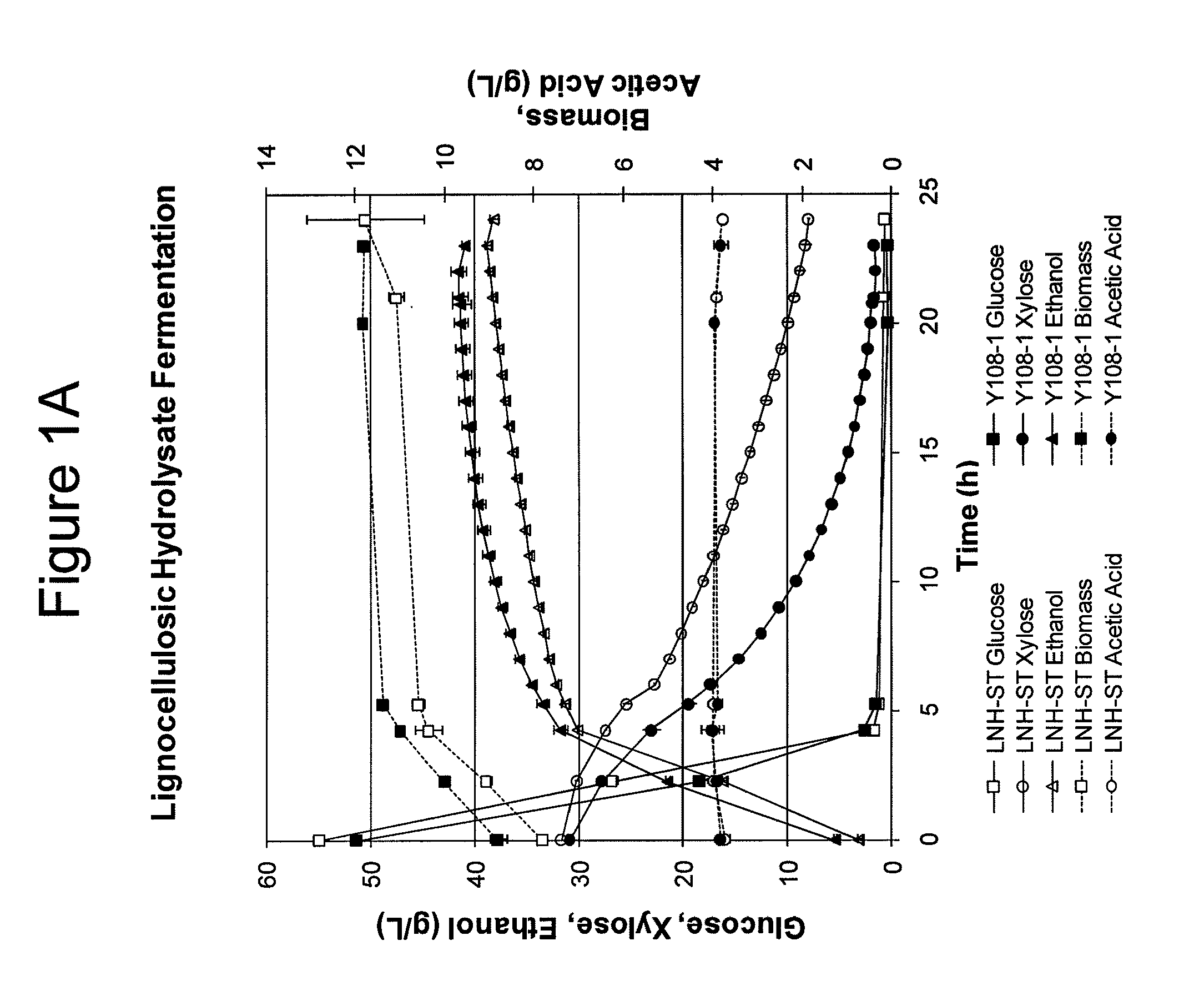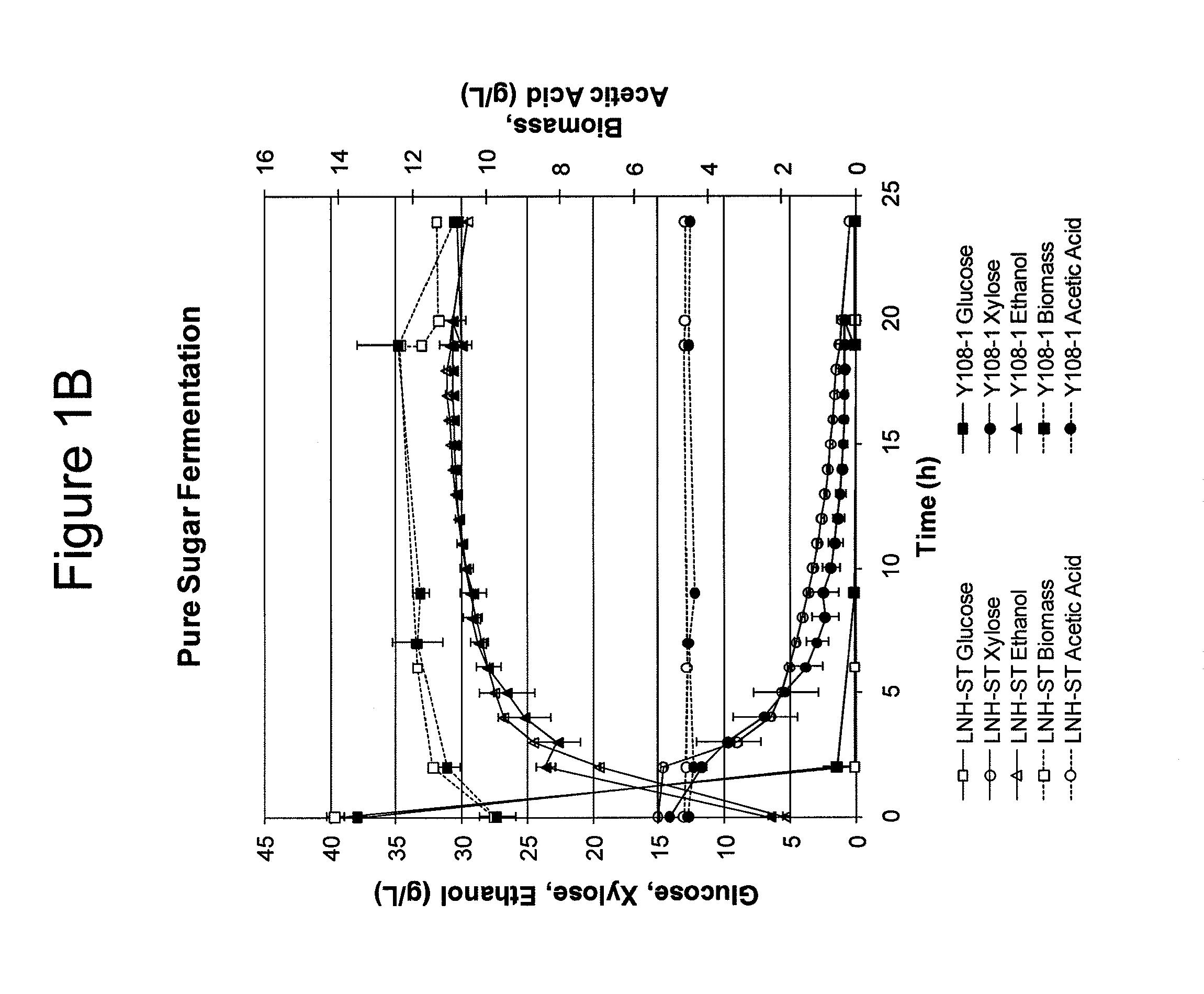Modified yeast strains exhibiting enhanced fermentation of lignocellulosic hydrolysates
- Summary
- Abstract
- Description
- Claims
- Application Information
AI Technical Summary
Benefits of technology
Problems solved by technology
Method used
Image
Examples
example 1
Evolutionary Engineering of a Parental Yeast Strain to Produce a Modified Yeast Strain with Enhanced Fermentation of Xylose in Lignocellulosic Hydrolysate
example 1.1
Feed Preparation
[0124]Hydrolysate from a dilute acid-pretreated lignocellulosic biomass, conducted as set forth in U.S. Pat. No. 4,461,648 (incorporated herein by reference), was concentrated by evaporation. Hydrolysate was mixed with pure sugar and nutrient components according to media recipe #1 (Media #1) in Table 2 (displaying components of Media #s 1, 2, 4, 5, and 6). Salts, trace elements, and yeast extract were added, on a per liter basis, to the chemostat feed. The trace solution was prepared according to Verduyn et al. (1992) Yeast 8(7):501-17, which is incorporated herein by reference.
TABLE 2Media RecipesMediaMediaMediaMediaMediaCompound#1#2#4#5#6Yeast Extract (g / L)51010——Peptone (g / L)—2020——(NH4)2SO4 (g / L)9——5—KH2PO4 (g / L)2——3—MgSO4•7H2O (g / L)2—— 0.5—CaCl2•2H2O (g / L) 0.4————Trace elements (mL / L)2——1—Glucose (pure) (g / L)0-10601260 —Glucose (lignocellulosic————60hydrolysate) (g / L)Xylose (pure) (g / L)0-4020——Xylose (lignocellulosic0-22—36—30hydrolysate) (g / L)Acetic acid (g / ...
example 1.2
Inoculum Propagation for Chemostat
[0127]A parental S. cerevisiae strain LNH-ST was prepared as described in U.S. Pat. No. 7,527,927 and contained several copies of the plasmid pLNH-ST (FIG. 15), containing the XR-, XDH- and XK-encoding genes integrated into its genome.
[0128]The parental strain LNH-ST (108 cells) was used to inoculate a 2 L baffled flask containing 1000 mL of media containing Media #2 from Table 2. Cells were cultivated for 48 h in a shaker incubator at 30° C. and 160 rpm. The entire contents of the flask were transferred aseptically to a controlled 7.5 L New Brunswick Bioflow III bioreactor containing 3 L of Media #1 with 10 g / L glucose and 0 g / L xylose. The culture was incubated for 3 h at the aforementioned conditions and then fed at a rate of 3 g glucose / h for 18 h. This initial propagation step provided a sufficiently large cell culture for the evolutionary engineering experiment.
PUM
| Property | Measurement | Unit |
|---|---|---|
| Fraction | aaaaa | aaaaa |
| Density | aaaaa | aaaaa |
| Density | aaaaa | aaaaa |
Abstract
Description
Claims
Application Information
 Login to View More
Login to View More - R&D
- Intellectual Property
- Life Sciences
- Materials
- Tech Scout
- Unparalleled Data Quality
- Higher Quality Content
- 60% Fewer Hallucinations
Browse by: Latest US Patents, China's latest patents, Technical Efficacy Thesaurus, Application Domain, Technology Topic, Popular Technical Reports.
© 2025 PatSnap. All rights reserved.Legal|Privacy policy|Modern Slavery Act Transparency Statement|Sitemap|About US| Contact US: help@patsnap.com



